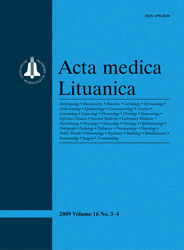Acta medica Lituanica
 ISSN 1392-0138 ISSN 2029-4174 (online) |
2011 m. Nr. 2 Radiological diagnostics of triple negative breast cancer: a review
Background. Triple negative breast cancer has a poor prognosis. Therefore, it is vital to detect this subtype of breast cancer in its early stage. The imaging features of this clinically important subtype of breast cancer are not well known. There have been no published reports about radiological diagnostics of triple negative breast tumour in Lithuania. The purpose of this study was to review the imaging characteristics of triple receptor negative cancers in mammography, ultrasonography and magnetic resonance imaging (MRI).
Materials and methods. The published data for the period 2006–2011 concerning the imaging of triple negative breast cancer were analyzed. There were ten retrospective, ten prospective studies and five reviews. Five studies were on mammography imaging, three on both mammography and ultrasonography imaging, and five studies dealt with MR imaging data. Two studies analysed all three diagnostic methods. Results. In mammography, triple negative breast (TRN) cancers often present as a mass and are most frequently round, oval or lobular in shape, less frequently being irregular. TRN tumours aren’t associated with calcifications. Moreover, architectural distortion is not a characteristic feature of triple negative breast cancer. In ultrasonography, TRN cancer appears as a parallel. TRN breast tumours mostly are irregular in shape and have a circumscribed margin. Attenuating posterior echoes and hypervascularity are not their characteristic features. In MR imaging, TRN breast cancer tends to have a lobulated, round or oval mass shape. Rim enhancement is identified in most of TRN tumours. Initially, rapid enhancement with a washout pattern (a sign of malignancy) does not usually apply to triple-negative breast cancers. Conclusions. TRN breast cancer is difficult to diagnose, because usually it has no specific imaging signs typical of breast cancer. In mammography, TRN cancers aren’t associated with microcalcifications. In ultrasonography, attenuating posterior echoes and hypervascularity are not characteristic features of TRN tumours. In MRI, initially rapid enhancement with a washout pattern does not usually apply to triple-negative breast cancers. Keywords: triple negative breast cancer, mammography, ultrasonography, magnetic resonance imaging |
Issues:
2011 - Vol.18 No. 1, No. 2, No. 3, No. 4 2010 - Vol.17 No. 1-2, No. 3-4 2009 - Vol.16 No. 1-2, No. 3-4 2008 - Vol.15 No. 1, No. 2, No. 3, No. 4 2007 - Vol.14 No. 1, No. 2, No. 3, No. 4 2006 - Vol.13 No. 1, No. 2, No. 3, No. 4 2005 - Vol.12 No. 1, No. 2, No. 3, No. 4 2004 - Vol.11 No. 1, No. 2, No. 3, No. 4 2003 - Vol.10 No. 1, No. 2, No. 3, No. 4 2002 - Vol.9 No. 1, No. 2, No. 3, No. 4 2001 - Vol.8 No. 1, No. 2, No. 3, No. 4 |